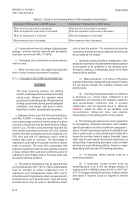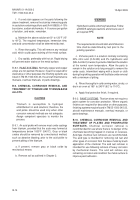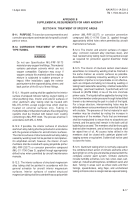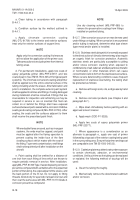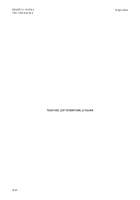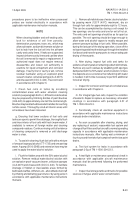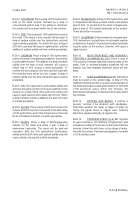TM-1-1500-344-23-2 - Page 223 of 240
B-21
NAVAIR 01-1A-509-2
TM 1-1500-344-23-2
15 April 2009
B-18. GENERAL.
This
section
describes
decontamination procedures to be followed after it has
been determined that a fuel system is contaminated
with salt water or microbiological growth. It is extremely
important that fuel system decontamination procedures
be initiated as soon as possible following evidence of
contamination, particularly if salt water contaminated,
because serious corrosion damage to metallic
components can begin within a few hours. Defueling,
depuddling and purging are required as part of
decontamination of the fuel system. Defueling shall be
done in accordance with instructions contained in the
applicable aircraft maintenance manual.
B-18.1. COMPONENTS REQUIRING SPECIAL
TREATMENT. Components such as cork floats, wiring
bundles, braided hose covering and capacitance type
fuel quantity indicators may require special treatments
which include removal and soaking in a hot cleaning
solution followed by scrubbing to remove residual salt
deposits and/or microbiological growth. When ultrasonic
cleaning equipment is available, cleaning time can be
shortened considerably.
B-18.2. WATER
EMULSION
CLEANING
COMPOUNDS. Water emulsion cleaning compounds
are specified to assist in cleaning grossly contaminated
systems. Since residues from these cleaning compounds
provide food for microorganisms leading to
microbiological growth, it is essential that thorough
fresh water rinsing follow their use.
B-19. SALT WATER CONTAMINATION.
Salt water
contamination of the aircraft fuel system does not
necessarily result in immediate engine fuel system
contamination. Therefore, fuel samples shall be obtained
from the engine fuel system beginning with main filters
and working downstream until the extent of salt water
penetration into the fuel system can be established. If
there is no evidence of salt water in the engine fuel
system, the system shall be disconnected and/or blanked
off to prevent possible contamination during fuel cell
and aircraft plumbing system decontamination.
B-19.1. DECONTAMINATION PROCEDURES.
WARNING
Sodium dichromate crystals (A-A-59123) are
toxic to the skin and eyes. Chemical or splash
proof goggles, rubber gloves (MIL-G-12223),
coveralls (MIL-C-2202), and a respirator
(GGGM-125/1) shall be worn when handling
these crystals.
CAUTION
To prevent possible damage to fuel system
nonmetallic components, the solution
temperature shall not exceed 120
°
F (49
°
C).
Do not allow sodium dichromate solution to dry
out on any metallic surface during treatment.
Ensure that cellulose sponges are in good
condition (i.e., not coming apart or shredding)
when used inside a fuel cell or tank. Also, to
prevent a fire hazard, cellulose sponges and
cheesecloth used for cleaning fuel cells or
tanks shall be disposed of in accordance with
local safety instructions.
B-19.2. To decontaminate the fuel system, proceed as
follows:
a. While the fuel system is still assembled, defuel
aircraft and drain remaining fuel using low point drains.
Include draining the engine fuel systems, if contaminated.
b. Prepare an inhibitor solution by adding 35 to 40
pounds of sodium dichromate crystals (A-A-59123) to
each 50 gallons of fresh water. To improve flushing
ability, use warm water (100
°
to 120
°
F (38
°
to 49
°
C)), if
available. The inhibitor solution will dissolve and remove
most of the residual salts, thus providing temporary
corrosion protection for metallic components.
APPENDIX B
SUPPLEMENTAL REQUIREMENTS FOR ARMY AIRCRAFT
SECTION V. DECONTAMINATION PROCEDURES FOR
SALT WATER AND
MICROBIOLOGICAL
GROWTH CONTAMINATION
Back to Top


